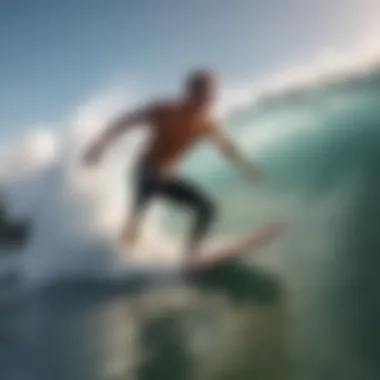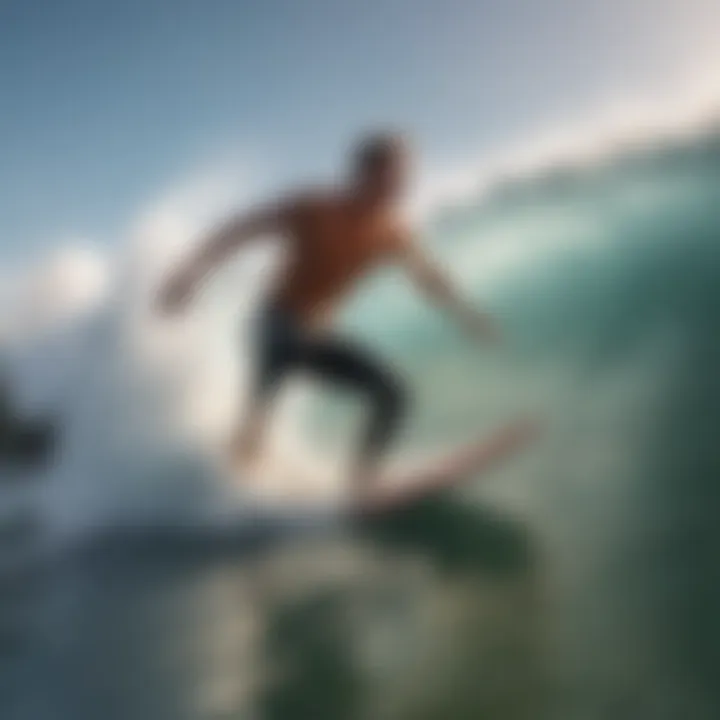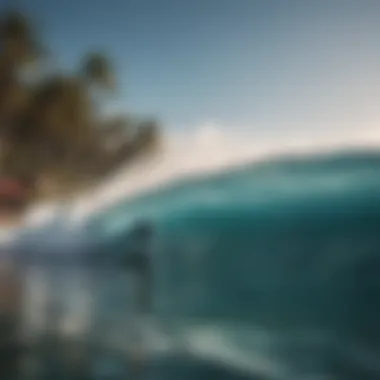Exploring the Rip Curl World Surf League


Intro
The Rip Curl World Surf League represents much more than just a series of competitions; it encapsulates the spirit and evolution of surfing as a cultural phenomenon. Established as a key player in the competitive surfing scene, the league has undergone various transformations, aligning itself to the shifting tides of surf culture and its environmental implications. This comprehensive overview will take you through the intricate tapestry of the league’s history, its notable events, and the influential figures that have shaped its course.
The allure of surfing isn't merely in the act itself; it’s in the community that thrives alongside it. The Rip Curl World Surf League connects surfers from all corners of the globe while confronting pressing issues like environmental sustainability and technological advancements. Join us as we navigate through these multifaceted layers to better understand how this league has cast its net far and wide, influencing the sport and surfing lifestyle we know today.
Prelims to the Rip Curl World Surf League
In the landscape of surfing, the Rip Curl World Surf League stands as a pivotal institution that shapes not only the sport but also its culture. Understanding the significance of this league is paramount for anyone who has a vested interest in the dynamics of competitive surfing. The league promotes an environment where surfers from all corners of the globe come together, sharing waves and showcasing their talents. It has morphed into a compelling platform that recognizes that surfing is more than just a pastime; it's a way of life for many.
Definition and Purpose
The Rip Curl World Surf League, often just referred to as the World Surf League (WSL), serves as the governing body for professional surfing competitions around the world. Essentially, it organizes events that are crucial for crowning world champions among surfers with skills that are nothing short of artistry on water.
In practical terms, the league's primary purpose is multifaceted:
- Competitive Framework: By providing a structured format for competitions, it ensures that talented surfers have opportunities to compete at various levels, showcasing their skills.
- Global Outreach: It promotes surfing as a sport on an international scale, attracting tourists and surf enthusiasts to locales that host these competitions. This, in turn, fosters economic growth in these regions.
- Cultural Significance: Beyond the competitive aspect, the league plays a crucial role in elevating surf culture, embodying values like camaraderie, respect for the ocean, and pushing the boundaries of what's possible on a surfboard.
In a nutshell, the league truely is the backbone of professional surfing, facilitating not just competitions but fostering a vibrant community of surfers who are passionate about their craft.
Historical Context
Tracing back to its roots, the World Surf League morphed from the International Professional Surfers (IPS) in the late ‘70s, evolving as surfing began to gain traction as a legitimate sport. In 2015, the chance for rebranding and reinvigorating competitive surfing arose with Rip Curl stepping in as a major sponsor. This partnership helped in distinguishing the league from earlier surfing competitions that lacked standardization.
Over the decades, the WSL has seen many transformations, adapting to the times while keeping the essence of surfing intact. For instance, the inclusion of various female competitions has added an essential layer of diversity, allowing women surfers to shine and compete on equal footing with their male counterparts.
From humble beginnings to now a recognized leader in the global surfing domain, the league has made significant strides in intertwining high-performance surfing with cultural and environmental consciousness. It reflects a history marked not only by competitions but also by a deeper commitment to surfing as a lifestyle and a means of ocean advocacy.
"The Rip Curl World Surf League is where talent meets opportunity, paving the way for future generations of surfers."
Through its storied evolution, the league exemplifies how much surfers care about their craft, community, and the ocean that binds them all together.
The Evolution of Competitive Surfing
The journey of competitive surfing is akin to riding a wave; it has its highs and lows, twists and turns. Understanding this evolution is essential for grasping how the Rip Curl World Surf League stands as a pinnacle in the sport. This growth reflects not just the sport's increased popularity but also a deepening appreciation of the ocean and its waves. With each change, surfers have found new challenges and opportunities that resonate with a broader audience, drawing in fans and participants alike.
Origins of Surf Competitions
In the murky waters of surfing history, the roots of competition can be traced back to the early 20th century. Initially, surfing was a leisurely activity, a show of skill and artistry rather than a race for medals. The first recorded surf competition took place in 1913 at Corona del Mar, California. This event marked a fledgling attempt to formalize what had largely been an informal tradition. Competitive vibes started brewing with few surfers gathering to test their skills against one another in different heats.
The 1950s and 60s saw a significant shift. Surfing was gaining traction, and events began popping up like mushrooms after rain. The formation of associations such as the United States Surfing Association helped legitimize surf competitions, paving the way for larger championships. Through these events, surfers weren't only battling against the waves; they were competing for recognition, fame, and community pride. This period also saw the advent of surf culture in media, where movies and magazines showcased both the sport and its lifestyle, capturing the imagination of surfers and wannabes alike.
The competitive concept matured as leagues and sponsorships emerged. As surfing transitioned from a niche pastime to a global phenomenon, so too did its contests. By the 1970s, competitions like the Smirnoff World Pro-Am Surfing Championship were attracting crowds and creating a spectacle, leading surfers to embrace the thrill of competition.
Development of the Rip Curl World Surf League
Fast forward to the 1980s and beyond: the Rip Curl World Surf League evolved from earlier contests into a structured and prestigious competitive arena. Rip Curl, founded in 1969, played a crucial role in this transformation, harnessing its influence and resources to elevate surfing's global footprint. The league kicked off as the Association of Surfing Professionals, converting into the current world league we recognize today.
This organizational shift was pivotal. Competitions were now held worldwide, setting the stage for surfers from all corners of the globe to showcase their mad skills in pursuit of the championship title. A ranking system was established, allowing surfers to accumulate points based on their performance at different events across a season, injecting a layer of strategy into the competition.
Key milestones along the way helped shape the league into the juggernaut it is now. The introduction of different tours, like the Men's and Women's Championship Tours, allowed for more inclusivity and representation in competitive settings. The league continually adapts to the sport's shifts; recent years have brought a focus on promoting environmental sustainability, reflecting the surfers' and fans' commitment to the oceans on which they rely.
As we observe this evolution, it becomes clear that the Rip Curl World Surf League is not just a series of events—it's a living tapestry of culture, skill, and a profound relationship with the ocean. The evolution, from humble local competitions to a celebrated global league, speaks volumes about how far surfing has come, and where it is heading is a topic well worth pondering.
Key Events of the Rip Curl World Surf League
Understanding the key events of the Rip Curl World Surf League is vital for grasping the landscape of competitive surfing. These events not only highlight individual talents but also promote the sport itself, drawing attention from enthusiasts and newcomers alike. The league's calendar is packed with dynamic contests that test the mettle of athletes while fostering community spirit among fans.
Annual Championship Tour
The Annual Championship Tour (ACT) is the cornerstone of the Rip Curl World Surf League. This tour operates as a series of events held at iconic surf locations across the globe, such as the famous Pipeline in Hawaii and the powerful waves of Margaret River in Australia. Each stop in the tour presents unique challenges, from varying wave conditions to differing local cultures, providing a true test of versatility for surfers.
Surfers accumulate points based on their performances throughout the tour. The points gained significantly influence their overall rankings, which are crucial for qualifying for future events. This point system not only enhances the competitive nature but also establishes a pathway for up-and-coming surfers to carve out their careers.


Key features of the ACT include:
- Diverse Locations: Surfers are pushed to adapt their techniques as they encounter different wave types and conditions in various parts of the world.
- Global Exposure: The league garners a massive global audience, bringing surf culture into the mainstream, thereby inspiring new athletes.
- Community Engagement: Many of the events include beach clean-ups and local outreach, promoting a sense of responsibility among surfers and the connected communities.
As the ACT unfolds, it serves as a microcosm of surfing evolution. Established competitors often face fierce challenges from emerging talents, creating thrilling narratives at every event. This mix of excitement and competition is what keeps the surf community buzzing.
Special Events and Contests
In addition to the Annual Championship Tour, the Rip Curl World Surf League hosts various special events and contests that bring flair to the competitive calendar. These events often have unique themes or formats that emphasize creativity and adaptability in surfing. For instance, the Rip Curl GromSearch encourages younger surfers to showcase their skills and creativity, acting as a launchpad for future stars.
Some noteworthy aspects of special events include:
- Team Competitions: Events like the World Surf League Team Challenge pit geographical regions against each other, creating camaraderie and rivalry simultaneously.
- Unique Formats: Certain contests may use alternative judging criteria, such as expression sessions, allowing surfers the freedom to innovate and showcase their unique styles.
- Cultural Celebrations: Many events are deeply rooted in local traditions, showcasing regional surf culture and giving back to those communities through various programs.
These special contests highlight the league's commitment to not just competition, but also community and culture in surfing. They demonstrate how diverse the sport can be, offering something for everyone—from the hard-core competitor to the casual fan gazing at the beach.
"The Rip Curl World Surf League is not just about the waves; it’s about the stories and connections we build along the shores of our ever-changing seas." – An avid surf community member
By engaging in both the Annual Championship Tour and the array of special events, the Rip Curl World Surf League not only promotes elite-level surfing but also nurtures the environment wherein new stars can rise, ensuring the sport's future is as vibrant as its history.
Prominent Athletes in the League
The world of competitive surfing is a vibrant mixture of talent, culture, and the relentless quest for sport’s evolution. Prominent athletes in the Rip Curl World Surf League (WSL) not only represent high skill levels but also embody the passion and spirit of the sport. Their journeys often inspire many, and their influence extends beyond mere competition; they foster community, promote environmental awareness, and serve as role models for emerging surfers.
Profiles of Top Surfers
When you think about surfing's most celebrated names, a few individuals come to mind. Each has carved a niche not just for their prowess on a wave but also for their contributions to surf culture.
Some notable figures include:
- Kelly Slater: With a staggering 11 world titles, Slater is often called the greatest surfer of all time. His innovative approach to surfing has changed techniques and set standards for the future.
- Stephanie Gilmore: An exceptional talent, Gilmore holds multiple world championships, making her one of the top female surfers. She is renowned for her stylish, fluid approach that blends artistry with performance.
- John John Florence: Known for his technical skill and dynamic style, Florence's impact on the sport is significant as he appeals to both traditionalists and the younger generation.
Each of these athletes showcases unique attributes: Slater with his ability to push boundaries, Gilmore with her elegance, and Florence with his fierce competitiveness. These traits echo through the waves they conquer and inspire innumerable fans and surfers worldwide.
Emerging Talents
While revered athletes dominate headlines, the next generation of surfers is making a splash of their own. It’s essential to recognize emerging talents as they are the future of the WSL and surf culture.
Looking at the junior circuits, several names are beginning to circulate:
- Coco Ho: Already making waves in both competitions and social media, she connects with younger surfers and fans, expanding the reach of female representation in the sport.
- Kanoa Igarashi: A mix of speed, skill, and charisma, Igarashi has quickly garnered attention for his performances on the World Tour.
- Sage Erickson: Rising through the ranks, Erickson embodies determination as she aims for the top echelon of women's surfing. She focuses on not just competing but also advocating for the environment.
Emerging surfers like these contributors shape the future landscape of surfing, ensuring that the sport remains innovative and inclusive. The mentorship provided by established athletes is crucial, as it nurtures these budding talents, offering them guidance rooted in experience and successful practice.
"There’s a saying in surfing: If you aren’t progressing, you’re ultimately regressing. Emerging talents remind us that the sport is always moving forward, with new styles, techniques, and perspectives."
Understanding the narratives of both top surfers and newcomers is integral to appreciating the evolution of the Rip Curl World Surf League. Their stories weave a rich tapestry of ambition, challenges, and shared love for the ocean. As these athletes continue to push the limits, they not only enrich themselves but uplift the entire surfing community.
Surfing Techniques and Styles
Surfing is not just a sport; it's an art form. Every surfer, whether seasoned or novice, gets on their board with a unique array of skills and techniques shaped by experience and individual flair. Understanding these techniques and styles is vital for anyone involved in the Rip Curl World Surf League and the surfing community at large. They shed light on how surfers ride waves, express their identity, and score points during competitions.
Wave Riding Techniques
Wave riding is the core of surfing, and it encompasses several nuanced techniques that define a surfer's performance. Each wave is different, which makes it crucial for surfers to adapt their riding style according to the wave conditions. Key techniques include:
- Bottom Turn: This initial turn after dropping down the wave is where surfers gain speed and set up for their next move. A good bottom turn can make all the difference in transitioning smoothly into more complex maneuvers.
- Cutback: One of the most recognizable moves in surfing, a cutback allows the surfer to redirect back towards the breaking part of the wave. This technique shows both control and style.
- Aerials: Taking off the top of the wave into the air is a risky yet thrilling technique that excites judges and spectators alike. These moves reflect a surfer's adventurous spirit and technical prowess.
"In surfing, it's not just the waves you ride, but the style with which you ride them that earns you respect."
Through countless hours on the water, surfers hone these techniques, leading to impressive performances. But beyond just the physical aspect, wave riding techniques contribute to the sense of freedom and artistic expression inherent in the sport.
Understanding Competitive Scoring


In competitive surfing, style alone won't grab the trophy. Surfers need to understand the scoring system that judges employ to evaluate their performance. Knowing what elements contribute to their scores can help surfers adjust their techniques and enhance their winning chances. Key factors include:
- Difficulty of Maneuvers: Judges assess the complexity of the moves executed. A high-risk move done cleanly scores higher than an easier maneuver.
- Execution: How well is the maneuver performed? Clean lines and fluid transitions can significantly positively impact a score.
- Speed and Power: A surfer must maintain speed throughout their ride, showcasing powerful turns and re-entries.
- Variety: Incorporating a mix of different maneuvers shows versatility. Surfing isn’t just about nailing one technique but rather employing a range of skills to keep things fresh.
Ultimately, understanding these factors allows surfers to maximize their potential during competitions while still enjoying the ride. The interplay between artistic expression, style, and competitive scoring creates a vibrant mosaic within the Rip Curl World Surf League.
The Role of Technology in Surfing
In the modern age, technology plays a pivotal role in almost every facet of our lives, and surfing is no exception. The advent of technological advancements has transformed how surfers interact with the ocean, compete in leagues, and analyze their performance. As the Rip Curl World Surf League continues to evolve, the integration of technology not only enhances the experience for participants but also for fans and stakeholders. This section explores how innovations impact equipment and how data analytics contributes to surfers' performance.
Innovations in Equipment
The innovation of surfboards has really taken a leap in recent years. Historically, boards were primarily made from foam and fiberglass, but advances in materials science have introduced a range of options. For instance, epoxy boards are lighter and more buoyant than their traditional counterparts. This permits surfers to gain speed more effortlessly.
Another significant development is the introduction of smart boards, fitted with sensors to capture a wealth of data during a ride. These boards can monitor metrics like speed, direction, and wave height, giving surfers real-time feedback about their performance. This feedback loop enables surfers to refine their techniques more effectively.
"Today’s surfboards tell a story, from the first paddle to the final wave!"
Some specialized fins have also been developed that can adaptably alter their shape or stiffness based on the wave conditions. As a result, surfers can experience vastly improved control and maneuverability. Other gadgets, such as wrist-mounted devices, help track personal statistics through GPS, further enhancing the athlete's ability to perform and analyze post-session.
Data Analytics in Performance
Data analytics has become a game-changer in competitive surfing. With the implementation of precise tracking technologies, coaches and athletes can access a plethora of performance data. This information can lead to insightful strategies both during practice and competitive events.
Surfers can analyze not just their wave-riding performance but also specifics like paddle technique and wave selection. The use of video analysis allows for frame-by-frame assessment, which enables surfers to identify areas for improvement in their style. For example, a surfer might use footage from sessions to understand how small adjustments in positioning can lead to big gains in overall performance.
Additionally, this data-driven approach aids in injury prevention. By understanding their physical capabilities through analytics, surfers can make informed decisions about training intensity and recovery.
In summary, technology is reshaping the landscape of surfing, from the boards they ride to the analysis of their performance. Surfers today are armed with tools that not only maximize their techniques but also deepen their understanding of the sport—leading to a more enriched experience with surfing as a whole.
Environmental Impact of Surfing
The world of surfing has been captivating millions for generations, but it also brings to light pressing environmental concerns that must not be ignored. In an aquatic dance between human activity and the delicate ecosystems of the ocean, understanding the environmental impact of surfing is paramount. This topic doesn’t just serve as a backdrop to the thrilling performances on the waves; it shapes the future roles of surfers as stewards of the sea. Improved awareness, behavior changes, and actions taken by the region’s surfing communities can make a tangible difference in preserving the natural habitat.
Sustainability Initiatives in the League
In response to the increasing concerns about sustainability, the Rip Curl World Surf League is taking significant steps to lead by example. One of the league's standout initiatives is the commitment to minimizing its carbon footprint. By introducing eco-friendly practices during their events and operations, such as using renewable energy sources and reducing plastic waste, they aim to set a new standard in the sporting world.
Some actions include:
- Eliminating Single-Use Plastics: Many competitions now take place with a strict ban on single-use plastics, pushing vendors and fans alike to adopt more sustainable alternatives.
- Waste Management Programs: The league has implemented comprehensive waste management strategies. For example, bins for recycling and composting are placed all around competition sites to encourage responsible waste disposal.
- Educational Campaigns: The Surf League collaborates with local organizations to host educational campaigns, ensuring that surfers and audiences understand how to minimize their environmental impact.
Through these initiatives, athletes and fans are inspired to practice and promote a lifestyle that respects and protects the ocean.
Ocean Conservation Efforts
Beyond the competitions themselves, there’s a broader commitment within the league to ocean conservation. This is increasingly crucial as climate change and pollution threaten marine life and coastal ecosystems. The league has partnered with various organizations that focus on beach clean-ups and water quality monitoring.
Their efforts include:
- Beach Cleanup Drives: Regularly organized events at various surf locations not only target the issue of litter but also raise awareness about the importance of keeping the beaches clean.
- Habitat Restoration Projects: The league has invested resources into habitat restoration, helping to revive and protect both coral reefs and coastal wetlands that serve as crucial ecosystems.
- Research Support: Funding initiatives that support marine biology research contribute to understanding the health of our oceans and how surfing can coexist with nature.
"The sea is the cradle of life. To surf is to dance on its surface and simultaneously take on the responsibility to protect its depths."
These activities not only reflect a genuine commitment to the environment but also inspire participants to be proactive in creating a sustainable future for surfing and ocean health. In joining forces with environmental organizations, the Rip Curl World Surf League shows that empathy towards nature and excitement for competitive surfing can indeed go hand in hand.
Cultural Influence of the Rip Curl World Surf League
Understanding the cultural influence of the Rip Curl World Surf League is essential to grasp the full impact of competitive surfing on global communities. This league doesn't just facilitate thrilling competitions; it also serves as a platform that molds contemporary surf culture. From its origins, the league has intertwined with the lifestyle, values, and aspirations of surfers worldwide. Through its events and influence, the league fosters a sense of community, creativity, and awareness, making surfers feel connected beyond mere competition.
Surf Culture and Community
The vibrant surfing community is built on camaraderie, shared experiences, and mutual respect. The Rip Curl World Surf League plays a pivotal role in shaping this dynamic. As surfers travel across the globe for competitions, they often engage with local communities, forming bonds that last well beyond the duration of the events. This interaction brings awareness to regional cultures while highlighting local issues, such as ocean health and environmental sustainability.


Consider the annual tours and events: they often bring together athletes who represent various backgrounds and nationalities. The exchange of ideas, techniques, and cultures enriches everyone's experience. Locals who come to watch the contests connect with surfers, sparking dialogues about surf culture and environmental stewardship. This connection showcases how surfing transcends recreational activity; it's a lifestyle and a unified movement.
Moreover, the league's commitment to inclusivity is noteworthy. Initiatives aimed at welcoming underrepresented groups into the surfing community help create an even broader sense of belonging. Programs designed for youth and women surfers promote diversity and break down barriers, ensuring that everyone who wants to ride a wave has the opportunity.
Art and Representation in Surfing
Art and representation are indispensable facets of surfing culture. From iconic surfboard designs to vivid murals at surf spots, artistic expressions reflect personal and communal identities among surfers. The Rip Curl World Surf League encourages this creativity by supporting artists and initiatives that merge surfing and art.
One remarkable example is the annual surf film festivals associated with the league. These events spotlight talent across filmmaking, photography, and visual art, showcasing stories that resonate within surf culture. Artists use their platforms to elevate surfing narratives, drawing attention to vital issues like climate change and ocean conservation.
By promoting collaborations between surfers and artists, the league helps to enhance the visual language of surfing. The unique aesthetics found in surf boutiques and galleries speak volumes about surfers’ experiences and values. This representation not only elevates the culture but also galvanizes a collective movement toward sustainability, encouraging responsible surfing practices and environmental awareness.
"Surfing is about connecting to nature and expressing one's personality. The Rip Curl World Surf League not only emphasizes competition but also beauty, creativity, and community connection."
Challenges Facing the Surfing Community
The surfing community, vibrant and dynamic, faces hurdles that impact both individual surfers and the broader culture. This section addresses critical challenges that can affect athletes’ performance and well-being, as well as the vitality of the surf culture itself. Embracing these discussions is essential for understanding the current state of competitive surfing and pushing it towards a sustainable future.
Competitive Pressures and Mental Health
Competition in the Rip Curl World Surf League can be as intense as a powerful set rolling in. Surfers are under constant pressure to perform, maintain their rankings, and secure sponsorships. This atmosphere can lead to significant mental health challenges, obscuring the joy that the ocean once provided. Mental strength becomes as crucial as physical prowess.
Surfers have begun to open up about their mental health struggles. By fostering a community that encourages dialogue on topics such as anxiety, depression, and performance stress, the league can help destigmatize these issues.
- Competitive pressures often manifest in:
- Worry over performance consistency
- Fear of injury affecting career longevity
- The impact of external expectations from fans and sponsors
Surfers are not just athletes; they are ambassadors of the ocean's spirit. When mental health becomes fragile under the weight of expectations, the consequences can ripple throughout the community. Hence, it's crucial for leagues to integrate mental wellness resources and support networks to help these athletes navigate turbulent waters both on and off the waves.
Environmental Challenges
The environmental concerns faced by surfing and ocean cultures come from many fronts, yet some issues dominate the landscape. The health of oceans is not merely a backdrop for competition; it’s the very foundation of surfing. From rising sea levels due to climate change to pollution that endangers marine ecosystems, the stakes are unbelievably high.
- Key environmental challenges include:
- Pollution: Plastic debris continues to plague beaches and oceans, directly affecting aquatic life and surfers alike.
- Climate Change: Altered wave patterns and ocean temperatures disrupt both surfable conditions and marine habitats.
- Coastal Development: Urbanization often leads to loss of surf spots, reducing access and quality of waves.
These issues pose difficult questions. How do surfers preserve their playground while advocating for more conscious interactions with the environment? Organizations like the Rip Curl World Surf League have started initiatives aimed at sustainability and conservation, but the push must grow stronger.
Conservation efforts can range from beach clean-ups to educational campaigns that emphasize the link between surfing and ocean health. Not only does addressing these environmental challenges improve surfers' experiences, but it also reinforces a shared responsibility towards the oceans. As the community evolves, so too must their commitment to safeguarding the surf culture's very essence.
“The ocean is our shared playground, but its health is in our hands.”
As we dive deeper into the surf culture and its interconnected challenges, understanding these key pressures on the surfing community paints a clearer picture of its future. With collaborative efforts, surfers can continue to embrace the waves while working towards a healthier planet.
Closure: The Future of the Rip Curl World Surf League
As we take a step back and consider where the Rip Curl World Surf League is headed, it’s important to recognize the significant shifts influencing the landscape of competitive surfing. Understanding these components not only sheds light on the league itself but also highlights the broader implications for the surfing community as a whole. Future developments will be informed by emerging trends, the evolving interests of athletes, and the responsibilities of organizations to navigate the delicate relationship between sport and environment.
"The dynamics of competitive surfing are constantly in flux—like the very waves that surfers ride; one must adapt or risk being left behind."
Emerging Trends in Surfing
In surf culture, trends come and go, but some have shown great staying power. One key trend is the increasing focus on inclusivity within the sport. More female surfers are making headlines, carving out their space and challenging long-held stereotypes. Events specifically tailored for women are on the rise, indicating a cultural shift towards equitable representation.
Additionally, there has been a noticeable push towards eco-conscious practices. Surfers advocate for sustainability, urging equipment manufacturers to create more environmentally friendly products. Innovative surfboard materials that minimize carbon footprints may just be the beginning.
- Eco-Friendly Boards: Companies like Firewire Surfboards focus on reducing waste and utilizing recyclable materials.
- Ocean Health Campaigns: Collaborations between surfers and conservationists aim to protect marine ecosystems.
- Youth Engagement: Emerging surf schools are creating pathways for younger generations, emphasizing both sport and environmental stewardship.
Predictions for Competitive Surfing
Looking ahead, we can anticipate changes in how competitive surfing is structured. The league is likely to embrace more technology, not only in terms of broadcasting but also in performance analytics. Imagine real-time feedback provided to athletes during events, enabling them to adapt their techniques to excel.
In terms of competition formats, more competitions might adopt live scoring, allowing fans to engage more dynamically throughout events. This could create a more electric atmosphere, drawing larger audiences both online and in-person—a benefit for everyone involved.
- Virtual Reality Training: In addition, virtual reality simulations may become a tool for competitor training, providing athletes with simulated conditions to practice in.
- Athlete Wellness Focus: Mental health resources specifically tailored for athletes might gain prominence. With surf culture’s intensity and pressures, it’s critical for leagues to prioritize mental health just as much as physical performance.
As we envision the Rip Curl World Surf League’s trajectory, it’s evident that futurescape is a canvas prepared for vibrant strokes. By embracing innovation, sustainability, and inclusivity, the league not only enhances its own reputation but supports the resilience and growth of the global surfing community.















